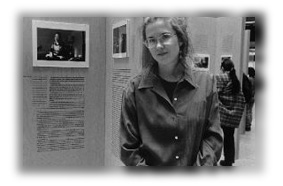Main Menu · Search ·Current Issue ·Contact ·Archives ·Centennial ·Letters to the Editor ·FAQs
For more alumni web resources, check out Harvard Gateways, the Harvard Alumni Association's website
 Rebecca Carman aims to make social problems accessible in a search for solutions.COPYRIGHT „ 1997 JOANNE CICCARELLO Rebecca Carman aims to make social problems accessible in a search for solutions.COPYRIGHT „ 1997 JOANNE CICCARELLO |
Slabs of natural wood formed three-sided towers in the lobby of the Boston Public Library. On them, black-and-white photographs and typewritten words portrayed with stark simplicity the faces and memories of 10 formerly homeless women, all of them abused at around age six. The display comprised a photo exhibit, called When I Was Six, by Rebecca W. Carman '87. Through her work for The Better Homes Fund (TBHF), a nonprofit organization dedicated to solving the problems of homelessness, Carman uses creative writing, art, and photography to "bring people face-to-face with this problem, so that they can't turn away or just ignore it or pretend that it doesn't exist. Because once you're aware of it," she adds, "you start asking questions like 'Is there a way I can help?'"
Carman taught portrait drawing and creative writing at the Cambridge-Somerville Social Club before starting at TBHF in 1988 as a part-time writer and editor. She took writing and photography classes in her time off. After a while, she began to blend her skills to produce "more creative pieces that would try to sell the stories of people who were being helped by the organization." In her work, she says she uses "the way that literature or art tries to appeal to the heart and the emotion" in order to achieve her goal, "a blend of public education and fundraising." She has now researched, designed, and written two informational brochures, one about preschoolers in a program called Kidstart and one about formerly homeless mothers and their case managers. Each took about a year to complete. Ellen Bassuk, president of TBHF and associate professor of psychiatry at Harvard Medical School, says of Carman's projects, "Even though we need to produce data, what makes it real and accessible--so policymakers can understand it--is this kind of work."
When I Was Six was on display at Boston Public Library last January. Carman was inspired to undertake the project by data from two Better Homes Fund research projects indicating extremely high rates of rape and abuse among women who had been homeless or were on AFDC. She wanted to show "the link between the early violence and the later homelessness" through individuals who had experienced it. She explains that, although she's "not trying to imply that abuse is what causes the homelessness per se, a higher proportion of homeless women and women in poverty have these experiences."
Most important to Carman are the positive effects the project has had on the women it features. She interviewed each woman for six to eight hours, and the text of the exhibit is drawn from their own words. Each woman's story starts out with a "memory image," her strongest recollection from her life at age six, which Carman also represented photographically in the exhibit. "I hoped the memory images would be like looking at the world through their eyes," she explains. Each woman read her story and saw her photos before the exhibit opened. "This project is such a sensitive thing," Carman notes. "The danger is that you would retraumatize people, that they would feel this was an exploitative thing." In fact, the opposite seems to have been the case; Carman describes in vivid detail the excitement she felt during the opening night discussion when several of the women in the exhibit felt comfortable and courageous enough to identify themselves and speak out. Ellen Bassuk agrees that "that's why these projects have been successful. These women have seen the exhibit as empowering."
Carman, who is now working toward a master's in social work from Smith, hopes to obtain funding so the exhibit can travel, possibly to the national conferences of Health Care for the Homeless and the Child Welfare League. Her next photoessay will probably be about "the men in these women's lives." Ultimately, she says, she is happy with the fact that during her time at TBHF, her "floating sense of a career" has become grounded in "meaningful work."
~Brooke Donovan